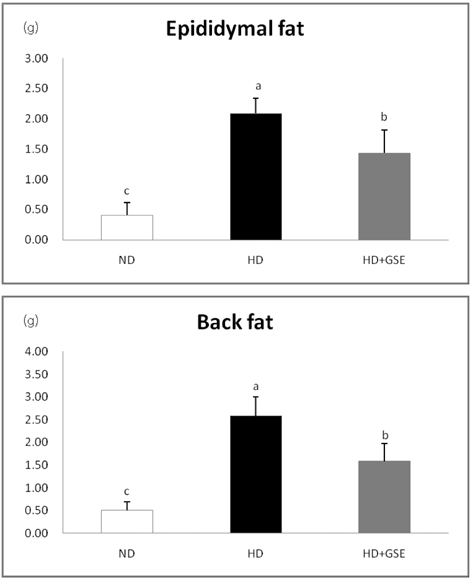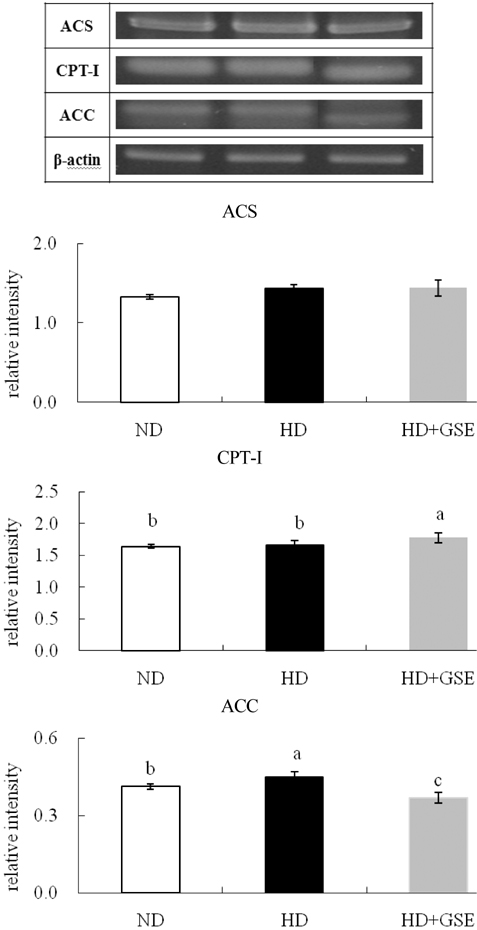Nutr Res Pract.
2008 Dec;2(4):227-233. 10.4162/nrp.2008.2.4.227.
Grape seed extract (Vitis vinifera) partially reverses high fat diet-induced obesity in C57BL/6J mice
- Affiliations
-
- 1Department of Food Science and Human Nutrition, Research Institute of Human Ecology, Chonbuk National University, 664-14 1Ga Deokjin-dong, Deokjin-gu, Jeonju, Jeonbuk 561-756, Korea. cha8@chonbuk.ac.kr
- 2Division of Endocrinology and Metabolism, Department of Internal Medicine, Chonbuk National University, 664-14 1Ga Deokjin-dong, Deokjin-gu, Jeonju, Jeonbuk 561-756, Korea.
- KMID: 2139196
- DOI: http://doi.org/10.4162/nrp.2008.2.4.227
Abstract
- The aim of the present study was to assess the anti-obesity effects of grape seed extract (GSE) supplement in C57BL/6J mice. Thirty mice were divided into three groups; normal diet control group (ND), high fat diet control group (HD) and high fat diet plus grape seed extract supplemented group (HD+GSE). Results were as follows: 1. GSE supplement reduced the weight gain in mice fed high fat diets; epididymal and back fat weights were lower compared to non-supplemented HD group. 2. Blood lipid concentrations were lower in the HD+GSE group than in the HD group. Serum HDL-C concentrations were higher in the HD+GSE group compared with the other groups. 3. The concentrations of acid-insoluble acylcarnitines (AIAC) in serum and liver were higher in the HD+GSE group than in the HD group. 4. GSE supplementation increased mRNA levels of lipolytic genes such as carnitine palmitoyltransferase-1 (CPT-1) and decreased mRNA levels of lipogenic genes such as acetyl CoA carboxylase (ACC). These findings suggest that grape seed extract supplements in high fat diet might normalize body weight, epididymal and back fat weights, lipid concentrations, and carnitine levels through controlling lipid metabolism.
MeSH Terms
Figure
Cited by 2 articles
-
Grape seed extract inhibits nucleus pulposus cell apoptosis and attenuates annular puncture induced intervertebral disc degeneration in rabbit model
Ogunlade B., Fidelis O. P., Adelakun S. A., Adedotun O. A.
Anat Cell Biol. 2020;53(3):313-324. doi: 10.5115/acb.20.047.Peanut sprouts extract (Arachis hypogaea L.) has anti-obesity effects by controlling the protein expressions of PPARγ and adiponectin of adipose tissue in rats fed high-fat diet
Nam E Kang, Ae Wha Ha, Hye Won Woo, Woo Kyoung Kim
Nutr Res Pract. 2014;8(2):158-164. doi: 10.4162/nrp.2014.8.2.158.
Reference
-
1. Achouri Y, Hegarty BD, Allanic D, Becard D, Hainault I, Ferre P, Foufelle F. Long chain fatty acyl-CoA synthetase expression is induced by insulin and glucose: Involvement of sterol regulatory element-binding protein-1c. Biochimie. 2005. 87:1149–1155.
Article2. Bagchi D, Bagchi M, Stohs SJ, Das DK, Ray SD, Kuszynski CA, Joshi SS, Pruess HG. Free radicals and grape seed proanthocyanidin extract: importance in human health and disease prevention. Toxicology. 2000. 148:187–197.
Article3. Bieber LL. Carnitine. Annu Rev Biochem. 1988. 57:261–283.
Article4. Bonnefont JP, Demaugre F, Prip-Buus C, Saudubray JM, Brivet M, Abadi N, Thuillier L. Carnitine palmitoyltransferase deficiencies. Mol Genet Metab. 1999. 68:424–440.
Article5. Cederblad G, Lindstedt S. A method for the determination of carnitine in the picomole range. Clin Chim Acta. 1972. 37:235–243.
Article6. Finer N. Medical consequences of obesity. Medicine. 2006. 34:510–514.
Article7. Formiguera X, Canton A. Obesity: epidemiology and clinical aspects. Best Pract Res Clin Gastroentenol. 2004. 18:1125–1146.
Article8. Gabetta B, Fuzzati N, Griffini A, Lolla E, Pace R, Ruffilli T, Peterlongo F. Characterization of proanthocyanidins from grape seeds. Fitoterapia. 2000. 71:162–175.
Article9. Hasler CM. The changing face of functional foods. J Am Coll Nutr. 2000. 19:499S–506S.
Article10. James PT. Obesity: The worldwide epidemic. Clinics in Dermatology. 2004. 22:276–280.
Article11. Jang JK, Han JY. The antioxidant ability of grape seed extracts. Korean Journal of Food Science and Technology. 2002. 34:524–528.12. Kim H, Hall P, Smith M, Kirk M, Prasain JK, Barnes S, Grubbs C. Chemoprevention by grape seed extract and genistein in carcinogen-induced mammary cancer in rats is diet dependent. J Nutr. 2004. 134:3445S–3452S.
Article13. Kim JY, Nolte LA, Hansen PA, Han DH, Ferguson K, Thompson PA, Holloszy JO. High-fat diet-induced muscle insulin resistance: relationship to visceral fat mass. Am J Physiol Regul Integr Comp Physiol. 2000. 279:R2057–R2065.
Article14. Koo BS, Seong SH, Kown DY, Sohn HS, Cha YS. Fermented kochujang supplement shows anti-obesity effects by controlling lipid metabolism in C57BL/6J mice fed high fat diet. Food Sci Biotechnol. 2008. 17:336–342.15. McGarry JD, Leatherman GF, Foster DW. Carnitine palmitoyltransferase I. The site of inhibition of hepatic fatty acid oxidation by malonyl-CoA. J Biol Chem. 1978. 253:4128–4136.
Article16. Memon RA, Fulle J, Moser AH, Smith PJ, Grunfeld C, Feingold KR. Regulation of putative fatty acid transporters and acyl-CoA synthetase in liver and adipose tissue in ob/ob mice. Diabetes. 1999. 48:121–127.
Article17. Mun EG, Soh JR, Cha YS. L-Carnitine reduces obesity caused by high-fat diet in C57BL/6J mice. Food Sci Biotechnol. 2007. 16:228–233.18. Pataki T, Bak I, Kovacs P, Bagchi D, Das DK, Tosaki A. Grape seed proanthocyanidins improved cardiac recovery during reperfusion after ischemia in isolated rat hearts. Am J Clin Nutr. 2002. 75:894–899.
Article19. Petro AE, Cotter J, Cooper DA, Peters JC, Surwit SJ, Surwit RS. Fat, carbohydrate, and calories in the development of diabetes and obesity in the C57BL/6J mouse. Metabolism. 2004. 53:454–457.
Article20. Pinent M, Blay M, Blade MC, Salvado MJ, Arola L, Ardevol A. Grape seed-derived procyanidins have an antihyperglycemic effect in streptozotocin-induced diabetic rats and insulinomimetic activity in insulin-sensitive cell lines. Endocrinology. 2004. 145:4985–4990.
Article21. Ryu MH, Cha YS. The effects of a high-fat or high-sucrose diet on serum lipid profiles, hepatic acyl-CoA synthetase, carnitine palmitoyltransferase-I, and the acetyl-CoA carboxylase mRNA levels in rats. J Biochem Mol Biol. 2003. 36:312–318.
Article22. Sachan DS, Rhew TH, Ruark RA. Ameliorating effects of carnitine and its precursors on alcohol-induced fatty liver. Am J Clin Nutr. 1984. 39:738–571.
Article23. Sano T, Oda E, Yamashita T, Naemura A, Ijiri Y, Yamakoshi J, Yamamoto J. Anti-thrombotic effect of proanthocyanidin, a purified ingredient of grape seed. Thromb Res. 2005. 115:115–121.
Article24. Shi J, Yu J, Pohorly JE, Kakuda Y. Polyphenolics in grape seeds-biochemistry and functionality. J Med Food. 2003. 6:291–299.
Article25. Shin ES, Cho SY, Lee EH, Lee SJ, Chang IS, Lee TR. Positive regulation of hepatic carnitine palmitoyl transferase 1A (CPT1A) activities by soy isoflavones and L-carnitine. Eur J Nutr. 2006. 45:159–164.
Article26. Suzuki H, Kawarabayasi Y, Kondo J, Abe T, Nishikawa K, Kimura S, Hashimoto T, Yamamoto T. Structure and regulation of rat long-chain acyl-CoA synthetase. J Biol Chem. 1990. 265:8681–8685.
Article27. Vaz FM, Wanders RJ. Carnitine biosynthesis in mammals. Biochem J. 2002. 361:417–429.
Article28. Vinson JA, Mandarano MA, Shuta DL, Bagchi M, Bagchi D. Beneficial effects of a novel IH636 grape seed proanthocyanidin extract and a niacin-bound chromium in a hamster atherosclerosis model. Mol Cell Biochem. 2002. 240:99–103.29. Yamakoshi J, Saito M, Kataoka S, Kikuchi M. Safety evaluation of proanthocyanidin-rich extract from grape seeds. Food Chem Toxicol. 2002. 40:599–607.
Article30. Yilmaz Y, Toledo RT. Health aspects of functional grape seed constituents. Trends in Food Science & Technology. 2004. 15:422–433.
Article31. Yoo MA, Chung HK, Kang MH. Evaluation of physicochemical properties in different cultivar grape seed waste. Food Sci Biotechnol. 2004. 13:26–29.
- Full Text Links
- Actions
-
Cited
- CITED
-
- Close
- Share
- Similar articles
-
- Neuroprotective effects of Vitis vinifera extract on prediabetic mice induced by a high-fat diet
- Effects of grape pomace on the antioxidant defense system in diet-induced hypercholesterolemic rabbits
- The Effect of Grape Seed Oil, Perilla Oil, or Corn Oil-Containing Diet on Lipid Patterns in Rats and Fatty-Acid Composition in Their Liver Tissues
- Suppression of oxidative stress by grape seed supplementation in rats
- Dual effects of a mixture of grape pomace (Campbell Early) and Omija fruit ethanol extracts on lipid metabolism and the antioxidant defense system in diet-induced obese mice



